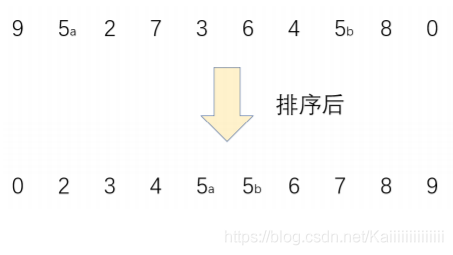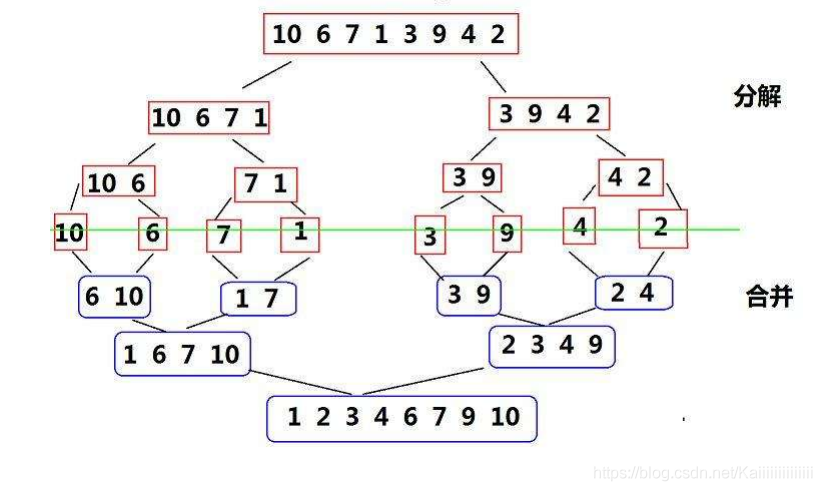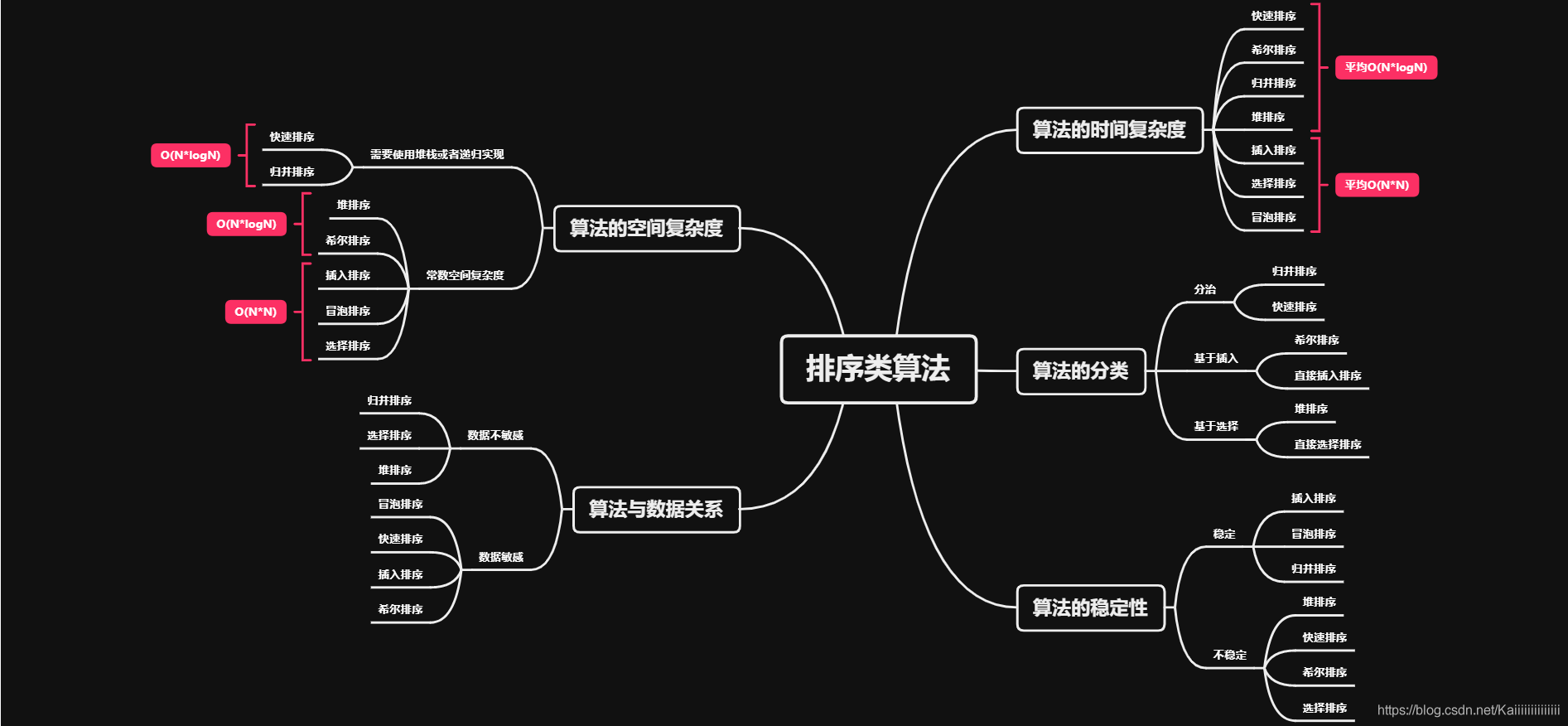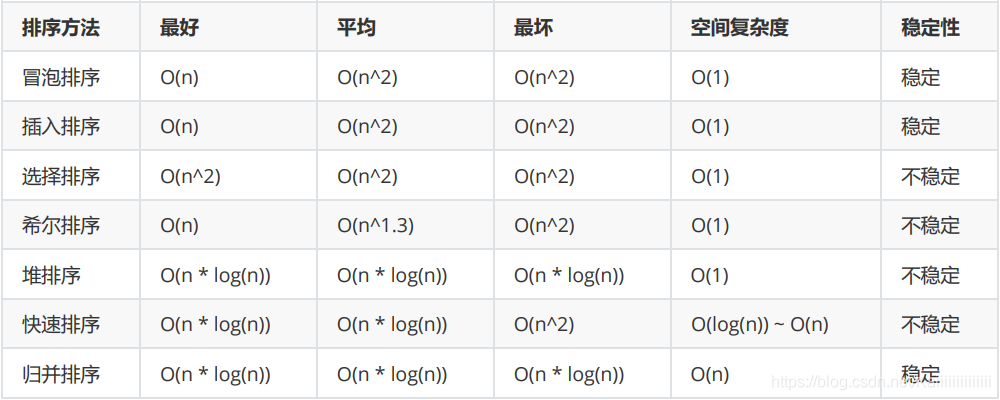本篇内容主要讲解“Java集合和数据结构排序的实例介绍”,感兴趣的朋友不妨来看看。本文介绍的方法操作简单快捷,实用性强。下面就让小编来带大家学习“Java集合和数据结构排序的实例介绍”吧!
概念
插入排序
直接插入排序
代码实现
性能分析
希尔排序
代码实现
性能分析
选择排序
直接选择排序
代码实现
性能分析
堆排序
代码实现
性能分析
交换排序
冒泡排序
代码实现
性能分析
快速排序
代码实现
性能分析
非递归实现快速排序
代码实现
性能分析
归并排序
归并排序
代码实现
性能分析
非递归实现归并排序
代码实现
性能分析
海量数据的排序问题
排序,就是使一串记录,按照其中的某个或某些关键字的大小,递增或递减的排列起来的操作。
平时的上下文中,如果提到排序,通常指的是排升序(非降序)。
通常意义上的排序,都是指的原地排序(in place sort)。
稳定性: 两个相等的数据,如果经过排序后,排序算法能保证其相对位置不发生变化,则我们称该算法是具备稳定性的排序算法。


整个区间被分为
有序区间
无序区间
每次选择无序区间的第一个元素,在有序区间内选择合适的位置插入
逻辑代码:
public class InsertSort {
public static void insertSort(int[] array) {
for (int i = 1; i < array.length; i++) {
int temp = array[i];
int j = i-1;
for (; j >= 0; j--) {
if (array[j] > temp) {
array[j+1] = array[j];
}else {
break;
}
}
array[j+1] = temp;
}
}
}调试代码:
public class TestDemo {
public static void main(String[] args) {
int[] array = {10,3,2,7,19,78,65,127};
System.out.println("排序前:" + Arrays.toString(array));
InsertSort.insertSort(array);
System.out.println("排序后:" + Arrays.toString(array));
}
}该代码的执行结果为:

可见,实现了对原数组的升序排序。
时间复杂度:
最好情况:O(n)【数据有序】
平均情况:O(n2)
最坏情况:O(n2)【数据逆序】
空间复杂度:O(1)
稳定性:稳定
对于直接插入排序:越有序越快。另外,直接插入排序会用在一些排序的优化上。
希尔排序法又称缩小增量法。希尔排序法的基本思想是:先选定一个整数,把待排序文件中所有记录分成个组,所有距离为的记录分在同一组内,并对每一组内的记录进行排序。然后,取,重复上述分组和排序的工作。当到达=1时, 所有记录在统一组内排好序。
希尔排序是对直接插入排序的优化。
当gap > 1时都是预排序,目的是让数组更接近于有序。当gap == 1时,数组已经接近有序的了,这样就会很快。这样整体而言,可以达到优化的效果。我们实现后可以进行性能测试的对比。
逻辑代码:
public class ShellSort {
public static void shell(int[] array,int gap) {
for (int i = gap; i < array.length; i = i + gap) {
int temp = array[i];
int j = i-gap;
for (; j >= 0; j = j-gap) {
if (array[j] > temp) {
array[j+gap] = array[j];
}else {
break;
}
}
array[j+gap] = temp;
}
}
public static void shellSort(int[] array) {
int[] drr = {5,3,1};//增量数组-->没有明确的规定,但保证为素数的增量序列
for (int i = 0; i < drr.length; i++) {
shell(array,drr[i]);
}
}
}测试代码:
public class TestDemo {
public static void main(String[] args) {
int[] array = {10,3,2,7,19,78,65,127};
System.out.println("排序前:" + Arrays.toString(array));
ShellSort.shellSort(array);
System.out.println("排序后:" + Arrays.toString(array));
}
}该代码的执行结果为:

可见,实现了对原数组的升序排序。
时间复杂度:
最好情况:O(n)【数据有序】
平均情况:O(n1.3)
最坏情况: O(n2) 【比较难构造】
空间复杂度:O(1)
稳定性:不稳定
每一次从无序区间选出最大(或最小)的一个元素,存放在无序区间的最后(或最前),直到全部待排序的数据元素排完 。
逻辑代码:
public class SelectSort {
public static void selectSort(int[] array) {
for (int i = 0; i < array.length-1; i++) {
for (int j = i+1; j < array.length; j++) {
if (array[i] > array[j]) {
int temp = array[j];
array[j] = array[i];
array[i] = temp;
}
}
}
}
}测试代码:
public class TestDemo {
public static void main(String[] args) {
int[] array = {10,3,2,7,19,78,65,127};
System.out.println("排序前:" + Arrays.toString(array));
SelectSort.selectSort(array);
System.out.println("排序后:" + Arrays.toString(array));
}
}该代码的执行结果为:

可见,实现了对原数组的升序排序。
时间复杂度 : 不管是最好情况还是最坏情况都是O(n2) 【数据不敏感】
空间复杂度: O(1)
稳定性:不稳定
基本原理也是选择排序,只是不在使用遍历的方式查找无序区间的最大的数,而是通过堆来选择无序区间的最大的数。
注意:排升序要建大堆;排降序要建小堆。
逻辑代码:
public class HeapSort {
public static void heapSort(int[] array) {
PriorityQueue<Integer> priorityQueue = new PriorityQueue<>(new Comparator<Integer>() {
@Override
public int compare(Integer o1, Integer o2) {
return o1-o2;
}
});
for (int i = 0; i < array.length; i++) {
priorityQueue.add(array[i]);
}
for (int i = 0; i < array.length; i++) {
array[i] = priorityQueue.poll();
}
}
}测试代码:
public class TestDemo {
public static void main(String[] args) {
int[] array = {10,3,2,7,19,78,65,127};
System.out.println("排序前:" + Arrays.toString(array));
HeapSort.heapSort(array);
System.out.println("排序后:" + Arrays.toString(array));
}
}该代码的执行结果为:

可见,实现了对原数组的升序排序。
时间复杂度:不管是最好的情况还是最坏的情况都是O(n * log(n)) 。
空间复杂度:O(1)。
稳定性:不稳定
在无序区间,通过相邻数的比较,将最大的数冒泡到无序区间的最后,持续这个过程,直到数组整体有序。
逻辑代码:
public class BubbleBort {
public static void bubbleBort(int[] array) {
for (int i = 0; i < array.length-1; i++) {
for (int j = 0; j < array.length-i-1; j++) {
if (array[j] > array[j+1]) {
int temp = array[j];
array[j] = array[j+1];
array[j+1] = temp;
}
}
}
}
}测试代码:
public class TestDemo {
public static void main(String[] args) {
int[] array = {10,3,2,7,19,78,65,127};
System.out.println("排序前:" + Arrays.toString(array));
BubbleBort.bubbleBort(array);
System.out.println("排序后:" + Arrays.toString(array));
}
}该代码的执行结果为:

可见,实现了对原数组的升序排序。
时间复杂度:
最好情况:O(n)【数据有序】
平均情况:O(n2)
最坏情况: O(n2) 【数据逆序】
空间复杂度:O(1)。
稳定性:稳定
从待排序区间选择一个数,作为基准值(pivot);
Partition: 遍历整个待排序区间,将比基准值小的(可以包含相等的)放到基准值的左边,将比基准值大的(可以包含相等的)放到基准值的右边;
采用分治思想,对左右两个小区间按照同样的方式处理,直到小区间的长度 = 1,代表已经有序,或者小区间的长度 = 0,代表没有数据。
逻辑代码:
public class QuickSort {
public static void quick(int[] array,int low,int high) {
if (low < high) {
int piv = piovt(array,low,high);//找基准
quick(array,low,piv-1);
quick(array,piv+1,high);
}
}
private static int piovt(int[] array,int start,int end) {
int temp = array[start];
while (start < end) {
while (start < end && array[end] >= temp) {
end--;
}
array[start] = array[end];
while (start < end && array[start] < temp) {
start++;
}
array[end] = array[start];
}
array[start] = temp;
return start;
}
public static void quickSort(int[] array) {
quick(array,0,array.length-1);
}
}测试代码:
public class TestDemo {
public static void main(String[] args) {
int[] array = {10,3,2,7,19,78,65,127};
System.out.println("排序前:" + Arrays.toString(array));
QuickSort.quickSort(array);
System.out.println("排序后:" + Arrays.toString(array));
}
}该代码的执行结果为:

可见,实现了对原数组的升序排序。
时间复杂度:
最好情况:O(n * log(n))
平均情况:O(n * log(n))
最坏情况: O(n2)
空间复杂度:
最好情况:O(log(n))
平均情况:O(log(n))
最坏情况:O(n)
稳定性:不稳定
逻辑代码:
/**
* 非递归实现快速排序
*/
public class QuickSortNor {
public static void quickSortNor(int[] array) {
int low = 0;
int high = array.length - 1;
int piv = piovt(array, low, high);
Stack<Integer> stack = new Stack<>();
if (piv > low + 1) {
stack.push(low);
stack.push(piv - 1);
}
if (piv < high - 1) {
stack.push(piv + 1);
stack.push(high);
}
while (!stack.isEmpty()) {
high = stack.pop();
low = stack.pop();
piv = piovt(array, low, high);
if (piv > low + 1) {
stack.push(low);
stack.push(piv - 1);
}
if (piv < high - 1) {
stack.push(piv + 1);
stack.push(high);
}
}
}
private static int piovt(int[] array, int start, int end) {
int temp = array[start];
while (start < end) {
while (start < end && array[end] >= temp) {
end--;
}
array[start] = array[end];
while (start < end && array[start] < temp) {
start++;
}
array[end] = array[start];
}
array[start] = temp;
return start;
}
}测试代码:
public class TestDemo {
public static void main(String[] args) {
int[] array = {10,3,2,7,19,78,65,127};
System.out.println("排序前:" + Arrays.toString(array));
QuickSortNor.quickSortNor(array);
System.out.println("排序后:" + Arrays.toString(array));
}
}该代码的执行结果为:

可见,实现了对原数组的升序排序。
时间复杂度: O(n * log(n))
空间复杂度:
最好情况:O(log(n))
最坏情况:O(n)
稳定性:不稳定
归并排序(MERGE-SORT)是建立在归并操作上的一种有效的排序算法,该算法是采用分治法(Divide and Conquer)的一个非常典型的应用。将已有序的子序列合并,得到完全有序的序列;即先使每个子序列有序,再使子序列段间有序。若将两个有序表合并成一个有序表,称为二路归并。

逻辑代码:
public class MergeSort {
public static void merge(int[] array, int start, int mid, int end) {
int s1 = start;
int s2 = mid + 1;
int[] temp = new int[end - start + 1];
int k = 0;
while (s1 <= mid && s2 <= end) {
if (array[s1] <= array[s2]) {
temp[k++] = array[s1++];
} else {
temp[k++] = array[s2++];
}
}
while (s1 <= mid) {
temp[k++] = array[s1++];
}
while (s2 <= end) {
temp[k++] = array[s2++];
}
for (int i = 0; i < temp.length; i++) {
array[i + start] = temp[i];
}
}
public static void mergeSortInternal(int[] array, int low, int high) {
if (low >= high) return;
//先分解
int mid = (low + high) / 2;
mergeSortInternal(array, low, mid);
mergeSortInternal(array, mid + 1, high);
//再合并
merge(array, low, mid, high);
}
public static void mergeSort(int[] array) {
mergeSortInternal(array, 0, array.length - 1);
}
}测试代码:
public class TestDemo {
public static void main(String[] args) {
int[] array = {10,3,2,7,19,78,65,127};
System.out.println("排序前:" + Arrays.toString(array));
MergeSort.mergeSort(array);
System.out.println("排序后:" + Arrays.toString(array));
}
}该代码的执行结果为:

可见,实现了对原数组的升序排序。
时间复杂度: O(n * log(n))
空间复杂度:O(n)
稳定性:稳定
逻辑代码:
/**
* 非递归实现归并排序
*/
public class MergeSortNor {
public static void merge(int[] array, int gap) {
int s1 = 0;
int e1 = s1 + gap - 1;
int s2 = e1 + 1;
int e2 = s2 + gap - 1 < array.length ? s2 + gap - 1 : array.length - 1;
int[] temp = new int[array.length];
int k = 0;
while (s2 < array.length) {
while (s1 <= e1 && s2 <= e2) {
if (array[s1] <= array[s2]) {
temp[k++] = array[s1++];
} else {
temp[k++] = array[s2++];
}
}
while (s1 <= e1) {
temp[k++] = array[s1++];
}
while (s2 <= e2) {
temp[k++] = array[s2++];
}
s1 = e2+1;
e1 = s1+gap-1;
s2 = e1+1;
e2 = s2 + gap - 1 < array.length ? s2 + gap - 1 : array.length - 1;
}
while (s1 < array.length) {
temp[k++] = array[s1++];
}
for (int i = 0; i < temp.length; i++) {
array[i] = temp[i];
}
}
public static void mergeSortNor(int[] array) {
for (int i = 1; i < array.length; i *= 2) {
merge(array, i);
}
}
}测试代码:
public class TestDemo {
public static void main(String[] args) {
int[] array = {10,3,2,7,19,78,65,127};
System.out.println("排序前:" + Arrays.toString(array));
MergeSortNor.mergeSortNor(array);
System.out.println("排序后:" + Arrays.toString(array));
}
}该代码的执行结果为:

可见,实现了对原数组的升序排序。
时间复杂度: O(n * log(n))
空间复杂度:O(n)
稳定性:稳定
外部排序:排序过程需要在磁盘等外部存储进行的排序
前提:内存只有 1G,需要排序的数据有 100G
因为内存中因为无法把所有数据全部放下,所以需要外部排序,而归并排序是最常用的外部排序。
先把文件切分成 200 份,每个 512 M
分别对 512 M 排序,因为内存已经可以放的下,所以任意排序方式都可以
进行 200 路归并,同时对 200 份有序文件做归并过程,最终结果就有序了
排序总结


到此,相信大家对“Java集合和数据结构排序的实例介绍”有了更深的了解,不妨来实际操作一番吧!这里是亿速云网站,更多相关内容可以进入相关频道进行查询,关注我们,继续学习!
亿速云「云服务器」,即开即用、新一代英特尔至强铂金CPU、三副本存储NVMe SSD云盘,价格低至29元/月。点击查看>>
免责声明:本站发布的内容(图片、视频和文字)以原创、转载和分享为主,文章观点不代表本网站立场,如果涉及侵权请联系站长邮箱:is@yisu.com进行举报,并提供相关证据,一经查实,将立刻删除涉嫌侵权内容。